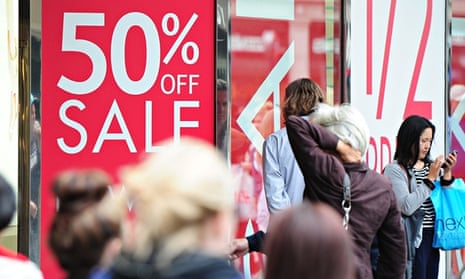Today, thousands are expected to descend on stores across the UK to snap up Black Friday deals. Visa Europe estimates that UK consumers will spend £360,000 a minute on their credit cards and make 8.5m online transactions.
Such is the frenzy, Greater Manchester Police have appealed for calm after “disturbances” in seven Tesco shops, in which three men have been arrested and a woman was hit by a falling television.
However, there is an alternative to this traditionally American annual occasion of queuing (people are even queuing online on the Currys website) or wrestling for brand new products.
Last week was #secondhandfirst week. Curated by Textile Recycling for Aid and International Development (TRAID), the initiative encourages people to commit to buying more used than new items.
We’ve asked those involved in the worlds of upcycling, refurbishing, mending and secondhand to share their thoughts on consumer perceptions of buying used. Can it ever generate as much excitement as Black Friday?

Janet Gunter, founder of The Restart Project
For gadgets like mobiles and computers, people often want guarantees, and even fear secondhand goods have been stolen. However some manufacturers sell refurbished electronics, and some retailers offer a year’s guarantee on secondhand electronics.
With household electricals like blenders, toasters and coffee machines, most people simply don’t know that they can buy high quality, tested appliances from charities like British Heart Foundation and Emmaus.
Likewise, people just don’t know where they can give their electricals away for reuse. So much of what can be reused and resold ends up going into recycling.
The stigma around secondhand electricals is probably not even related to an “ewww” factor, it’s more that people think this stuff is already designed to break, so why bother with secondhand? Like anything else, there are more durable brands available from secondhand charities. Being an informed consumer counts for a lot.

Maria Chenoweth-Casey, CEO of Traid
In the UK there is a well-established culture of charity shops, and a growth in independent vintage shops, which has helped to remove many of the barriers around buying secondhand. But social and economic stigmas still exist and need to be overcome. Charity shops are often perceived as chaotic, musty, moth-eaten places, which usually isn’t true.
There is an ongoing battle with the influence of advertising and the media which pushes us to buy more and dresses, often because they’ve been worn by Z-list celebs. Nevertheless, people are willing to buy secondhand clothes due to a thriving and creative charity retail sector. At the opening Traid’s new store in Peckham, London there were long queues and strong sales proving that there is a huge appetite for secondhand clothes from a wide market segment.
Changing behaviour is vital and part of this process is encouraging people to become more conscious of the environmental and social impacts of their clothes, which in turn encourages them to value their clothes for longer. Looking to already existing resources to fulfil our needs is a powerful way to create a more sustainable society.

Max McMurdo, founder of Reestore
I established Reestore in 2002 when I became uneasy with the way British culture had become all about consumerism and throwaway fashion. I had been living in Cologne as a car designer and decided to create a furniture design and manufacturing company producing items from everyday waste. There are still barriers towards secondhand but they are a lot smaller than when I started out.
Customers initially thought I was a bit of a hippy on a mission to save the planet one shopping trolley at a time, and almost expected an upcycled or secondhand item to be inferior or badly made. Quite often it’s actually the opposite as UK designer-makers are an extremely skilled bunch. Decent secondhand furniture is made from much better materials and constructed in a superior way to modern chipboard items.
It’s a slow process to get people to embrace secondhand. We can’t bully people to change their consumer habits overnight. Firstly we must give them beautiful, affordable, eco-friendly alternatives rather than trying to guilt trip them.
I believe shows like Kirstie’s Fill your House for Free have enlightened viewers and inspired them. The items sourced, designed and made on the show have demonstrated that you don’t have to buy a worn out looking item as a compromise but that it can add beauty and personality to a room.

Jane ni Dhulchaointigh, inventor and CEO of Sugru
I invented Sugru (a mouldable glue that feels like playdough but acts like superglue and sticks to pretty much anything), to try to get the world fixing again but over the years it’s turned into something much more than that.
We’ve seen thousands of people using it to customise everything from kitchen knives and earphones through to jewellery, bags and shoes. People want their products to work for them and buying new doesn’t always satisfy these days. Of course as someone who’s been raving about the environmental and creative potential of building a new culture of repair for a few years now, it’s really great to see this idea gaining traction.
Fixing things gives you a thrill. There’s a sense of having beaten the system in some small way. I’m certain that this growing fixing movement is related to the changing attitudes to buying secondhand. If people feel more confident in making small modifications to things - whether it’s clothes, furniture or other household items, ‘faulty’ will increasingly be seen as an opportunity for a project.

Tom van Deijnen, founder The Visible Mending Programme
I think many people still associate secondhand clothes with being poor and would rather have cheap, poor quality new clothes than secondhand ones that might be a bit love-worn.
If you want to follow the latest trends, then you need to be creative with what you can find secondhand and this can be a challenge not everybody is willing to take on. I started out with knitting as a hobby and then became interested in making and repairing knitwear and clothes in general. This led to The Visible Mending Programme, which highlights that the art and craftsmanship of clothes repair is particularly relevant in a world where people increasingly voice their dissatisfaction with fashion’s throwaway culture.
People who are slowly but surely accepting secondhand are probably already aware of the implications surrounding fast fashion. The challenge lies in appreciating style over low price, and a willingness to invest in an item and wear it for multiple seasons.
More like this:
- Black Friday scuffles: ‘I got a Dyson but I don’t even know if I want it’
- Black Friday in the US - in pictures
- Brought to you by Unilever: Unilever initiative helps 25 million people gain toilet access by 2020
The sustainable living hub is funded by Unilever. All content is editorially independent except for pieces labelled brought to you by. Find out more here.
Join the community of sustainability professionals and experts. Become a GSB member to get more stories like this direct to your inbox
